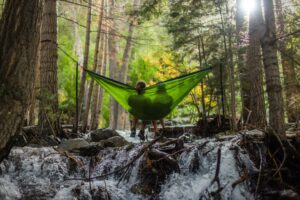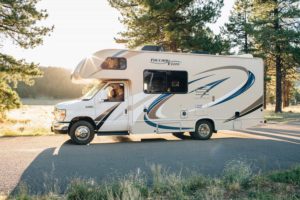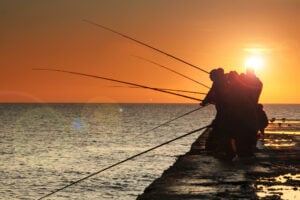A-frame: A basic tent shape where the cross section resembles the letter ‘A’. These tents are typically not very big and may be suitable for 1-2 people.
Back tack: A type of stitch that includes one sewn over another. This is commonly used when trying to reinforce highly stressed areas usually attaching two pieces of fabric together. High quality tents usually use back-tack stitching.
Bathtub floor: A tent floor that curves upwards to keep the stitching away from ground moisture. This is used in many waterproof tents.
Bear bag: Waterproof, protective bags that campers use to protect their food and cooking supplies while camping in areas where bears live. These bags are attached to rope so that they can be suspended out of the reach of bears and other animals.
Billy: A small metal container used to boil water or cook food over a campfire. Billy cans typically have a handle on the top of the container for convenient cooking.
Bivouac: The site where an improvised shelter is set up.
Bivy sack: A small one-man tent, or sleeping bag, often used as emergency shelter. This type of shelter is most commonly used by soldiers, or mountain climbers.
Canopy: A pop up shelter that is collapsible and portable. Canopies are perfect for a campsite and provide extra shelter against the sun and rain fall.
Car camping: When a campsite is set up near where a campers’ car is parked, this can be referred to as ‘car camping’. This is most common for families who might not want to carry all of their supplies in a campsite. It is also very useful when campers are visiting other locations.
Carabiner: A metal clip that is used to attach ropes or anchors while climbing or simply carrying different utilities.
Cowboy camping: This style of camping requires no tent or shelter. Cowboy camping describes sleeping under the stars, with just a sleeping bag, or nothing at all.
Daypack: A smaller sized backpack that holds enough supplies for a one-day outing.
Deadman: A log or rock that is buried in the ground and is used to provide a solid point for anchoring a tent in ground too soft for stakes.
Dome: A tent shape where poles are curved forming a dome.
Four-season tent: This type of tent is unique for its ability to stay durable throughout all four seasons. This includes harsh Canadian winters.
Freestanding tent: A tent that does not require stakes to be stationary. The tent poles of this type of tent often connect to a peg at the base of the tent.
Gear loft: A storage space located in a tent, usually meant for smaller items. The gear loft is most often made of a small panel of mesh or fabric that can be hooked to the roof of the tent.
Ground stakes: Anchors that hold a tent to the ground.
Guyline: A cable that is used to add stability to a tent and helps keep a tent dry.
Kindling: Small, thin often dead wood that is used to start a fire.
Marquee: A large tent normally used for dining or meeting.
Mummy bag: A close fitting hooded sleeping bag that is fitted for comfort and conserving body heat.
Pole sleeves: Fabric sleeves on the outside of a tent where tent poles are inserted.
Rain fly: A tent cover that keeps a tent waterproof and windproof.
S’Mores: Camping dessert that consists of chocolate and toasted marshmallow sandwiched between graham crackers.
Stake puller: A tool used to remove tent stakes from the ground.
Tent pad: Areas of sand, cement, gravel, or mulch that helps pitch a tent on a level surface.
Ultralight tent: A tent that is usually designed for one or two people. The ultralight tent weighs about five pounds or less and is designed to carry on a backpack.



